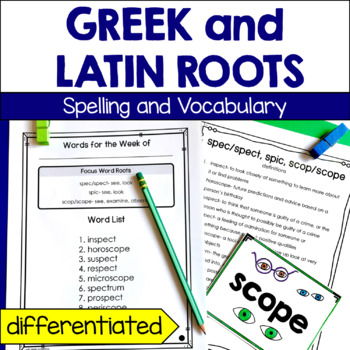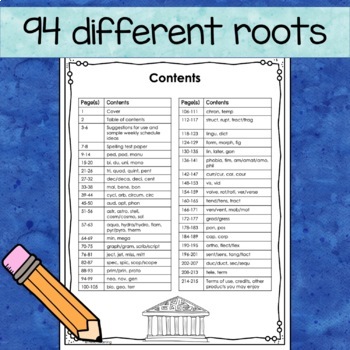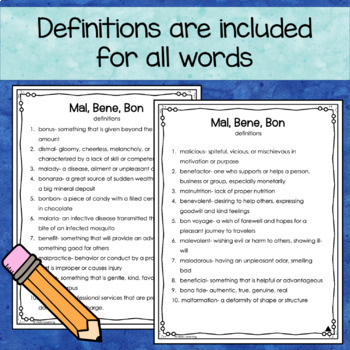Greek and Latin Roots Spelling and Vocabulary
- PDF
What educators are saying
Description
Are you looking for a way to improve your students reading, writing, spelling and vocabulary skills? This Greek and Latin roots spelling and vocabulary program will be the perfect resource for you! Students will learn Greek and Latin roots through spelling words and word study in this easy to use resource!
Click on the green PREVIEW button above to see more details about this resource!
What is included:
- 34 Greek and Latin word root units
- 94 different word roots
- 2 differentiated spelling lists for each unit (a basic word list and a challenge word list)
- 10 words on each spelling list
- definition lists for ALL words included in the program
- word root cards for each root word - students can make flashcards and word collections
- weekly spelling schedule ideas
- spelling test paper
This 34 week spelling program covers 94 common Greek and Latin roots. Each week focuses on a set of word roots that are similar or focus on a certain theme (numbers, body parts, water etc..).
For each of the 34 weeks there are two different spelling lists. This will allow you to use this product with different grade levels or allow you to differentiate spelling for your students. There are also definition lists to go along with each of the spelling lists. The two lists for each unit focus on the same word roots, so you can introduce the roots as a whole class and have students working on spelling words on their level.
Learning Greek and Latin roots will help your students become better spellers, writers, readers and vocabulary masters! Many words in the English language are built from Greek and Latin roots. Knowing these roots will help students understand the English language and the meaning of words more easily.
Roots included:
ped, pod, man, bi, du, uni, mono, tri, quad, quint, pent, deca, deci, cent, mal, bene, bon, cycl, orb, circum, circ, aud, opt, phon, astr/aster, stell, cosm, sol, aqua, hydr, flam, pyro, therm, min, mega, graph, gram, scribe, script, ject, mis, mit, spec/spect, spic, scop/scope, prim, prin, proto, neo, nov, gen, bio, geo, terr, chron, temp, struct, rupt, fract/frag, lingu, dict, form, morph, fig, lin, later, gon, phobia, tim, am/amat, phil, curr/cur, cor/cour, vis, vid, volv, rot, vers, tend/tens, tract, ven/vent, mob/mot, grad/gress, pon, pos, cap, corp, ortho, flect/flex, sent/sens, tang/tact, duc/duct, sec/sequ, tele, term.
This product is also available as part of a bundle of Greek and Latin Resources:
Follow me and be notified when new products are added to my store. New products are always 50% off for the first 24 hours they are posted!





